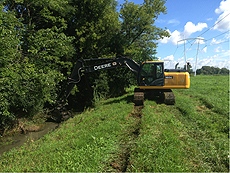Best laid plans won't go awry
 |
| Even routine actions like cleaning out ditches on site could have subtle impacts on the site's ecology. Proper planning and review by knowledgeable experts can prevent unnecessary damage. Photo: Fermilab Roads and Grounds |
We are justifiably proud of our environmental stewardship at Fermilab. We take great pride in our conservation efforts, including prairie reconstruction and care of other plant and animal communities on the site. We enjoy our role as a natural area asset for our neighbors. We have institutionalized that attitude through the Fermilab Ecological Land Management Committee, and Fermilab Natural Areas exists to augment the efforts to care for our ecosystem.
But Fermilab is big! We occupy more than 10 square miles of territory, and most of it is not heavily developed, so there is an abundance of diverse plant communities and habitat for wildlife. We are home to more than 300 species of birds, dozens of butterfly and moth species, and even more than 50 species of dragonflies and damselflies! Francois Rabelais famously observed that "nature abhors a vacuum," and almost anywhere you look on the Fermilab site, you will find plants and animals living there. However, we have a mission to study physics, and that means we have to alter the environment and disturb ecological entities to build our experiments, roads, beamlines and other support structures. How can we fulfill this mission and still protect the environment?
Construction is often a messy business. Disturbing the ground with backhoes and excavators can create erosion problems and destroy habitat. There are ample opportunities for spills to occur, and even the design of the project can set up unfortunate ecological situations that may persist for many years. How can we prevent, or at least minimize, these potential ecological snags?
A major part of the answer is proper planning. All actions, including maintenance and construction, must undergo a review to identify potential environmental impacts under the National Environmental Policy Act, or NEPA. At Fermilab, our ES&H Manual contains a chapter (8060) that explains this review process, but it is a very broad review, and it requires many different kinds of expertise to adequately protect the environment from possible sources of harm. Much of the NEPA review is centered on specific statutes and regulations such as the Clean Air Act or Department of Energy orders governing radioactivity. Because an ecological review in most cases does not require compliance with specific laws, it is much more difficult and requires expertise that few people possess. How many reviewers would be expected to know that even drainage ditches can harbor populations of the rare river bluet damselfly?
The solution is for everyone who is responsible for planning a project that will occur outdoors to check first with his or her environmental officer to obtain the information necessary to mitigate potentially damaging activities. Most times, a plan can be devised that will get the job done in a more ecologically sound manner.
—Rod Walton
|